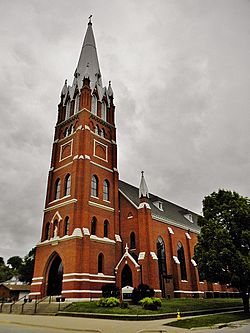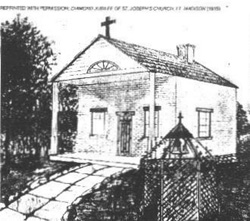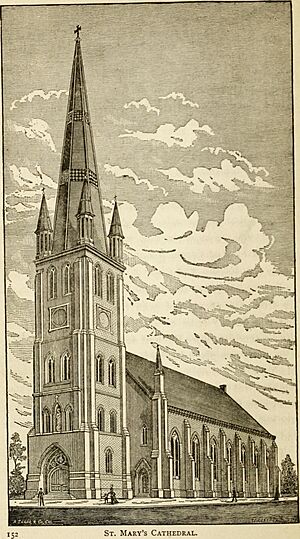Holy Family Catholic Church (Fort Madison, Iowa) facts for kids
Quick facts for kids Holy Family Catholic Church |
|
|---|---|

St. Mary of the Assumption Church
|
|
| 40°38′0″N 91°19′0″W / 40.63333°N 91.31667°W | |
| Location | 1111 Avenue E Fort Madison, Iowa |
| Country | United States |
| Denomination | Roman Catholic |
| Administration | |
| Diocese | Davenport |
Holy Family Catholic Church is a special church community, also called a 'parish,' that belongs to the Diocese of Davenport. It was formed when two other church communities, Saints Mary and Joseph Parish and Sacred Heart Parish, joined together in Fort Madison, Iowa, USA. The church still uses both of the old church buildings for services.
Before this, the oldest church in town, St. Joseph, had already joined with St. Mary of the Assumption in the 1990s. St. Mary of the Assumption Church, which became Saints Mary and Joseph, is located at 11th Street and Avenue E. This building was added to the National Register of Historic Places in 1980. Sacred Heart Church is located at 23rd Street and Ave I. In 2014, St. Mary's Church, its rectory (where the priest lives), and its convent (where the nuns lived) were recognized as important buildings within the Park-to-Park Residential Historic District on the National Register of Historic Places.
Contents
History of the Churches
St. Joseph’s Church: The First Catholic Church
The Catholic Church in Fort Madison began with a missionary priest named John George Alleman. He held the first Mass in the home of John Gerhard Schwartz. Mr. Schwartz also helped build the first Catholic church in the community. St. Joseph parish was officially started in 1840.
Father Alleman also started the first church school, called a parochial school, at St. Joseph's and was its first teacher. The School Sisters of Notre Dame from St. Louis were the first nuns to teach there. Later, the Congregation of the Humility of Mary took over teaching. The school grew to include both elementary and high school grades. The last church building for St. Joseph's, which is still standing, was built in 1886. It was the smallest of the three Catholic Churches in Fort Madison. The last Mass was held in this church on November 17, 2007.
St. Mary of the Assumption Church: A New Beginning
Fort Madison's second church community started with some disagreements. In 1857, the pastor of St. Joseph's, Father Alexander Hattenberger, wanted a bigger church in a more central location. However, the American Civil War put these plans on hold.
Later, in April 1865, land was bought for a new school and church. On September 3, 1865, a riot broke out among church members who did not want the church to move. This disagreement caused many delays in building for eight years. The new school building was dedicated on November 9, 1865. It was named Kreutz Erhohung Schule, which means "Exultation of the Cross School." This name honored the day (September 14) when the School Sisters of Notre Dame came to Fort Madison in 1860.
Construction on the new church began with the laying of the cornerstone on July 18, 1866. The new church was dedicated on January 1, 1871. In January 1874, the new church community was officially named St. Mary of the Assumption. It started with 1,000 members and grew to 2,500 by 1893. At that point, the community was divided to create Sacred Heart parish. German was spoken in the church for many years, but English became more common in the early 1900s. During World War I, the use of German stopped completely.
Building St. Mary's Church
The church building was designed by Walsh & Schmidt, an architectural firm from St. Louis, Missouri. The cornerstone was placed on July 8, 1866. The building is about 172 feet (52 meters) long and 72 feet (22 meters) wide. A wooden spire was added to the tower in 1872, making it 225 feet (69 meters) tall. The church cost $40,000 to build, and with the spire and inside furnishings, the total cost was about $100,000.
The outside of the church is made of red brick with a tall central tower and spire. Inside, there are three main sections, called naves. Large wooden altars were installed in 1881. On July 3, 1876, a tornado hit Fort Madison, causing the tower to collapse into the church. The church and tower were quickly rebuilt, but it took 14 years to build a new spire. A new rectory was built in 1887. The new spire was designed by Mathias Snell and was completed for $7,000. A 12-foot (3.7-meter) tall cross sits on top, rising 217 feet (66 meters) above the ground. Colorful glass windows were put in in 1892.
Music and School at St. Mary's
A pipe organ in the church was destroyed when the tornado hit. It was replaced in 1878 by a new organ. This organ was damaged again in 1890 during the construction of the new spire. It was repaired in 1942 and again in the late 1980s. In 1986, it was recognized as the largest pipe organ of its kind still existing.
The parish school taught elementary grades from the beginning and had its first high school graduates in 1922. Nuns taught the younger students and older girls, while lay teachers taught the older boys. A new convent was built in 1888. A larger school building was built in 1899. This building stopped being a school in 1977 and burned down in 1979. The current convent was built in 1911. In 1985, a new parish center was built where the old school used to be.
Sacred Heart Church: The Third Parish
The third church community in Fort Madison, Sacred Heart, was started in the Santa Fe neighborhood. A priest from St. Joseph's, Father Louis DeCailly, opened a school in a tin shop on September 8, 1892. The Sisters of Humility taught there. Sacred Heart Parish was officially started the next year, in 1893. It was the only one of the original three churches founded after the Diocese of Davenport was created in 1881.
When it started, Sacred Heart had 65 families and 54 students in the school. On December 8, 1893, a building that served as both a church and a school was dedicated.
Building Sacred Heart Church
In 1897, Henry Heying donated land and money to build a new church. The cornerstone for the current church building was laid on April 16, 1899. The church was dedicated on October 15, 1900. It was built in the Romanesque Revival style and is about 145 feet (44 meters) long and 60 feet (18 meters) wide. The outside is covered in Bedford stone. It has a corner tower and spire, and a statue of the Sacred Heart is on the front gable of the facade. Three bells were added to the tower, weighing 7,000 pounds (3,175 kg), 5,500 pounds (2,495 kg), and 3,000 pounds (1,361 kg). The inside has three naves, and it also has a pipe organ.
Sacred Heart School and Hospital
Like the other two churches, Sacred Heart had its own school. Unlike the others, Sacred Heart School only had elementary grades. From 1893 to 1983, the School Sisters of Notre Dame taught there. An addition was built onto the school in 1921, and a large convent was built next door. A social hall was built in 1927, a kindergarten building in 1942, and a new school building replaced the old one in 1955.
The church also started Sacred Heart Cemetery in 1909. Sacred Heart Hospital was built next to the church in 1912. It was founded by the Sisters of the Third Order of St. Francis. In 1977, it became Fort Madison Community Hospital. The original hospital building now holds offices for the Lee County Health Department.
Church and School Mergers
The Catholic schools in Fort Madison began to merge first. Both St. Joseph's and St. Mary's high schools joined in 1925 to form Catholic Central High School. A new high school, Aquinas High School, opened in 1959.
The three churches continued to run their own grade schools until 1966. At that time, St. Joseph's, St. Mary's, and Sacred Heart elementary schools combined to form St. Joseph's Middle School for 7th and 8th graders. St. Joseph's K-6 students then went to St. Mary's. Sacred Heart and St. Mary's continued their own grade schools until 1977. Then, they combined to form Aquinas East and Aquinas West. By the 1990s, the Catholic schools in Fort Madison and nearby West Point were having difficulties. The two school systems merged, and a new school called Holy Trinity opened in July 2005.
The number of people living in Fort Madison and the number of priests in the Diocese of Davenport began to change in the late 1900s. Fort Madison's population decreased, and people's church habits changed. The diocese also had fewer priests. Because of these changes, a plan was made to combine church communities. St. Joseph's and St. Mary's merged in 1996, forming Saints Mary and Joseph Parish. In 2009, Saints Mary and Joseph merged with Sacred Heart, creating the Holy Family Parish we know today.




